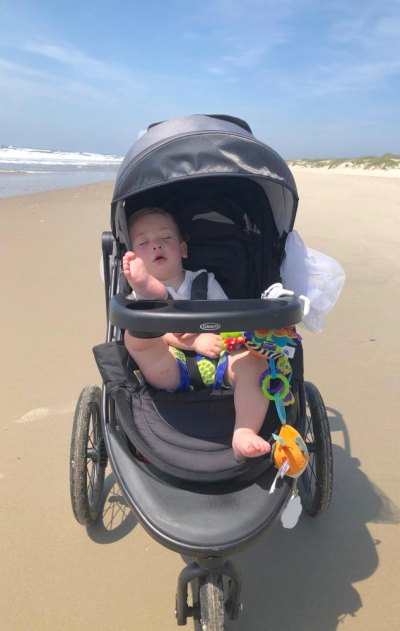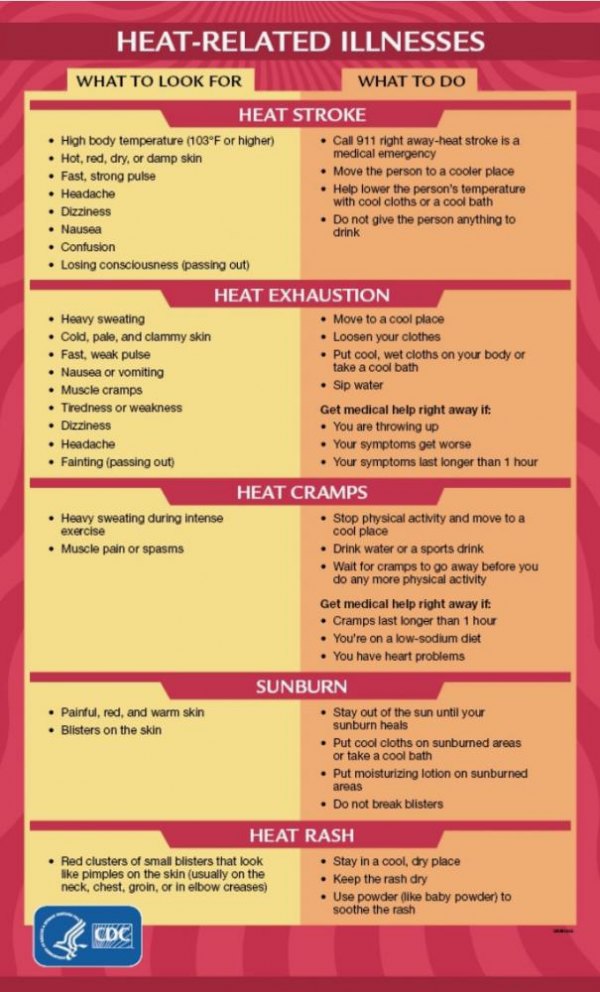Stay Safe Under the Sun

Hello, Ocracoke Current readers! It’s been a minute since I’ve contributed anything to this publication, so I might have much to say in this article. My inspiration for this article’s topic – Outdoor Safety – came from a walk I did not complete last Sunday afternoon. In the two miles to get to the Lifeguard Beach from my house, a lot can and does happen. Then stuff can really get real once you’re on the beach.
When I left my house Sunday afternoon I assumed the beach would be easy to walk, as it has been most every time I go walking. As I pulled Grady’s stroller behind me down the sandy ramp to the lifeguarded beach (I learned pulling the stroller is far easier than pushing it over the soft sand) I noticed how far back from the water people had set up their gear. That’s odd, I thought, but kept going along, getting looks from people indicating they thought I’d lost my mind to be even attempting what I was attempting. As I neared the water, I noticed a sharp drop off – called a scarp – had formed from rough water and high tides pounding the shoreline. I walked for what felt like foreverrrrr before spotting a place that I could ease Grady and his stroller closer to the water.
People playing beach games looked at me in disbelief as I struggled to get through the soft sand; others offered sympathetic expressions as if saying, “Well, bless her heart.” A combination of sweat, insect repellent, and sunscreen dripped into my eyes as my glasses slid down my nose, making this whole situation even more comical. I’m out there in a tank top, long pants, and running shoes, with my child in his stroller, on an unseasonably hot day, only to find the struggle of the soft sand wasn’t going to end when I got onto the wet sand. Oh no, that was juuuuuust the beginning. I looked up the tide chart for Ocracoke and soon realized why I was struggling. I also knew I would continue struggling because we’d arrived just after high tide. But I’d gotten this far, so I wasn’t about to turn around. I also wasn’t about to admit defeat, especially not in front of all those visitors, and with the stroller sinking into the sand I wasn’t about to get us stuck trying to turn around, so onward I went!
I made it about halfway to the NPS campground before giving in. Usually we do make it to the campground, but I was not about to test my will anymore than I had already. I felt inspired by this experience and decided that for greater good I’d let everyone know to check the tides before making any big plans for a lengthy beach walk so you don’t end up in a similar situation. I did get a great workout but WOW! I had a time. Navigating the beach can turn into quite a task, which is why I’m always prepared with insect repellent, sunscreen, and water. Read on for some sound advice (backed up by science!) about how to prevent injury while enjoying the coastal outdoors!
I have found that gauging insect numbers in the village gives one a false sense of security and confidence. Thanks to Beaver Tillett, the number of mosquitoes and other biting insects in the village is much lower than beyond the village. The soft sound of the repellent and sight of the subsequent cloud coming from his pick-up truck are glorious, and after he’s cruised down the streets of Ocracoke I see posts of celebration on Facebook about Beaver and his mosquito sprayer, proving that not all heroes wear capes. The mosquito truck really has made a difference in our yard, which becomes a bayou/mosquito breeding ground after even a small rain. So when I make it out the front door, can water the flowers, wash the car, and play with Grady in the baby pool without even seeing a biting insect, let alone getting a bite from one, it makes me overly optimistic, but as soon as I pass ORV Ramp 72 – South Point Road – the insects make their presence known almost instantly.
Over the last week I’ve seen various Ocracoke friends sharing an article from Treehugger.com that states the CDC has confirmed oil of lemon eucalyptus – or OLE – can be just as effective as DEET to repel mosquitoes. I was skeptical of the “findings” and wondered how much of what I read I could believe, so I took the link to the CDC website then onto the EPA site to investigate. Sure enough, OLE can be effective as a mosquito and tick repellent, but it doesn’t discuss the effectiveness of any repellent against deer flies, greenheads, and black biting flies. The CDC also discusses that it hasn’t evaluated non-EPA registered repellents, including natural repellents, so going strictly off what’s currently available on the CDC’s website here’s a list of EPA-registered ingredients that are proven to be safe and effective in repellents, even for pregnant and breastfeeding women:
- DEET
- Picardin
- IR3535
- Oil of lemon eucalyptus (OLE)
- Para-methane-diol (PMD)
- 2-undecanone
I’m an OFF! Deep Woods or OFF! Family Care kind of woman and overall it has kept me from getting mosquito and deer fly bites. The only effective way I’ve found to get rid of greenheads is to let them land on you then smack the you-know-what out of ‘em. Since I try to only use natural products on Grady, I use some all-natural fig insect repellent on him and always cover his stroller with a mosquito net if we go on a – as I call them – Mommy and Grady Adventure (which essentially means leaving the house and going anywhere beyond our yard), which will lead me into my next topic: sun and heat exposure!
It gets hot here, and as a Northern transplant to this sub-tropical ribbon of sand, I’ve learned that I don’t sweat; I glisten. In fact, I glisten a lot. And to make sure I continue glistening in a healthy way I bring all the water I can pack for any outing beyond the village. I love the heat and humidity, so I like to be outside for extended amounts of time. As I mentioned earlier, I typically walk to the beach, and before I head out I pack water for me and Grady (if he’s coming with me), bring a wet rag to wipe the sweat – er – glitter from my brow, and get Grady’s sunshade situated on his stroller.
These are basic supplies I take to prevent either one of us from becoming dehydrated or overheated. And don’t worry; I take great care of Grady in the heat and am well aware of how he’s doing. Usually, he’s playing with a plushy turtle, poking at his mosquito net, or napping. Getting outside in all kinds of temperatures is fun; my parents let me swim in the North Sea, and I turned out okay. At the time my lips were a bit purple, but I was having fun, just like Grady is doing when he’s out with me!
But to get back on topic, there are some things about water consumption that we often think are fact that are straight up false. A fact-check article by Aaron B. Carroll in the New York Times explains that whole we-need-eight-glasses-of-water-a-day thing is a myth. What many people fail to consider is that CDC guidelines for hydration encompass food and liquid intake that comes from sources including but not limited to plain water. We can consume water through fruits, vegetables, beer, coffee, and tea because water is in all of those things. The author – and the CDC - goes on to explain that even though water is the best beverage to consume it’s not the only way to stay hydrated, and our bodies are fine-tuned to tell us when we’re thirsty long before we become dehydrated. Just drink when you're thirsty! It's that simple.
Since I’m a beach-walker, I’m fully exposed to the sun whenever I’m out there. Grady has a little canopy on his stroller, but I always put on my SPF 30 full-spectrum sunscreen and make sure Grady has on his SPF 50 full spectrum sunscreen (we use Alba brand sunscreen because it’s reef-safe and cruelty-free). Grady doesn’t like to wear socks (who can blame him?) but he does like propping his feet up on the tray on his stroller, so I spray the top and underside of those little piggies.
People can get sunburned in as little as 15 minutes, but the physical signs can take anywhere from 2 to 6 hours to appear, so by the time you see the burn your skin is already damaged. In an article in Business Insider, NYU Health Dermatologist John Zampella explains that sun exposure can be a crucial part of a healthy lifestyle, but it’s important to keep your skin covered in at least SPF 30. Reapplying your sunscreen every two hours is a good way to insure you’re protected from the sun’s harmful rays and suggests applying sunscreen is incorporated into our everyday routines.
The American Academy of Dermatology (AAD) stresses the importance of using SPF 30 sunscreen and the organization goes on to explain choosing a product that’s water-resistant and has broad-spectrum protection is essential for sun exposure safety. The AAD also urges people to apply their sunscreen 15 minutes before heading outside so your skin can absorb the lotion, saying that if you apply it once you’re already exposed to the sun you’re likely to get burned. Re-applying immediately after swimming or sweating is also recommended. There are some benefits to sun exposure, though. Vitamin D3 synthesis, as explained in a 2018 article in Consumer Reports, occurs due to sun exposure and that process is essential to calcium absorption, which makes our bones strong. Recent studies indicate that UV exposure might lower blood pressure and be linked to longevity, but the dangers of over and/or unprotected sun exposure still outweigh the benefits. So, soak in the sunscreen so you can safely enjoy the sunshine!
While enjoying the long summer days it’s also important to be aware of heat exhaustion and heat stroke. The Mayo Clinic details symptoms of heat exhaustion to include heavy sweating and rapid pulse, both of which happen because your body is overheating. Overheating can occur when you’re doing strenuous exercise/labor intensive activities during periods of high heat and humidity. Feeling your muscles cramp is the earliest sign that you are in danger of experiencing a heat related illness, so if you feel that muscle cramping it’s time to get out of the sun and cool off. By ignoring the muscle cramping you run the risk of getting heat exhaustion which can lead to heat stroke. Heat stroke is a life-threatening condition, but it’s totally preventable. Signs of heat-related illness include: nausea; confusion; dizziness and fainting; fatigue; hot, red, dry, or damp skin; and a fast, strong pulse. If you experience one of these or multiple symptoms, it’s crucial for your safety to lower your body temperate immediately. Below is a CDC chart detailing heat-related injuries, what to look for, and what to do if you experience any of the symptoms.
Enjoy the summer wherever you are and do so safely!




